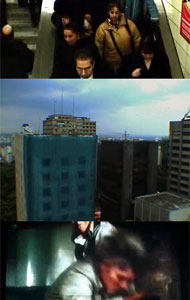|
|
Date:
Project Type: Net Cinema


Exercise for Peter Horvath's
Triptych: Motion, Stillness, Resistance
Description
Triptych is a generative (see glossary), three-paneled video that explores the dynamics of motion, resistance, and stillness. Each panel of Triptych features a series of images that construct a visual metaphor for one of these dynamics. The images are derived from the artist's own personal experience but are abstracted (i.e. they don't refer to specific moments) in order to evoke a more universal emotional quality. The three videos that comprise Triptych are compiled at random from images stored in a database. This random order is the result of an algorithm (see glossary) written by the artist. Triptych is triggered each time it is viewed, thereby making each viewing a unique and one-time rendering of the piece. Please note that there is no audio component to this work.
Purpose
The goal of this exercise is twofold: To explore the concept of database art and how databases can be used creatively and to consider how the personal relates to the universal.
Instructions/Notes
- There is no audio component to this piece.
- Please see supplementary document for a list of popular databases.
Exercise
Warm-Up Activity (5 min): The educator should facilitate a conversation about databases. Suggested questions could include:
- What is a database?
- What kind of information does it store?
- What are some popular databases?
- The educator should ask students if they have encountered any databases before.
Play (10 min):Students should watch Triptych. The educator should encourage students to launch the work multiple times and to observe the changing sequences of images.
Follow-Up Discussion (10 min): The educator should facilitate a discussion of the piece. Suggested questions could include:
- What is the role of the viewer in this work?
- How does the artist define the different dynamics of motion, stillness, and resistance? (Go through each dynamic separately.)
- Do these dynamics relate to the students' lives or how they understand these dynamics?
- What in this work is random and what is controlled?
- Are students surprised that the work comes from a database?
Activity (25 min): Breaking up into pairs, students should create a database of their memories. The educator should suggest large concepts like "childhood" or "food," and students should describe ten different images that correspond with these concepts on cue cards. Each set of cue cards constitutes a database of images. Students should sort their cue cards into different themes. One suggested category could be 'feelings' such as surprise, happiness, frustration, disappointment. At the end of the class, students should present their different categories, and illustrate one of the cue cards with a story.
|






